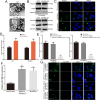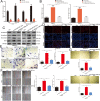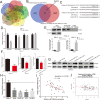Exosomal miR-106b-5p derived from melanoma cell promotes primary melanocytes epithelial-mesenchymal transition through targeting EphA4
- PMID: 33741023
- PMCID: PMC7980627
- DOI: 10.1186/s13046-021-01906-w
Exosomal miR-106b-5p derived from melanoma cell promotes primary melanocytes epithelial-mesenchymal transition through targeting EphA4
Abstract
Background: Cancer-secreted exosomal miRNAs regulates the biological processes of many tumours. The serum level of exosomal miR-106b-5p is significantly increased in melanoma patients. However, the role and molecular mechanisms of exosomal miR-106b-5p in melanoma remains unclear.
Methods: Quantitative real-time polymerase chain reaction (qRT-PCR) was used to detect the expression of miR-106b-5p and EphA4 in melanoma tissues. Transmission electron microscopy (TEM) and western blotting were used to identify exosome. QRT-qPCR and Cy3-labelled miR-106b-5p were used to demonstrated the transmission of melanoma cell-secreted exosomal miR-106b-5p. Western blotting, Immunofluorescence, adhesion, transwell and scratch wound assay were used to explore the role of exosomal miR-106b-5p in melanocytes. Luciferase reporter assays and RNA-Chromatin Immunoprecipitation (ChIP) assay were used to confirm whether erythropoietin-producing hepatocellular carcinoma receptor A4 (EphA4) was a direct target of miR-106b-5p.
Results: We found that miR-106b-5p levels were increased in melanoma tissue, and high miR-106b-5p expression is an independent risk factor for the overall survival of patients with melanoma. miR-106b-5p is enriched in melanoma cell-secreted exosomes and transferred to melanocytes. Exosomal miR-106b-5p promotes the epithelial-to-mesenchymal transition (EMT), migration, invasion and adhesion of melanocytes. Exosomal miR-106b-5p exerted its role by targeting EphA4 to activate the ERK pathway. We demonstrated that exosomal miR-106b-5p promoted melanoma metastasis in vivo through pulmonary metastasis assay.
Conclusions: Thus, melanoma cell-secreted exosomal miR-106b-5p may serve as a diagnostic indicator and potential therapeutic target in melanoma patients.
Keywords: EMT; EphA4; Exosomal; Melanoma; miR-106b-5p.
Conflict of interest statement
The authors declare that they have no competing interests.
Figures






Similar articles
-
Exosomal miR-21-5p derived from gastric cancer promotes peritoneal metastasis via mesothelial-to-mesenchymal transition.Cell Death Dis. 2018 Aug 28;9(9):854. doi: 10.1038/s41419-018-0928-8. Cell Death Dis. 2018. PMID: 30154401 Free PMC article.
-
Colorectal cancer-derived exosomal miR-106b-3p promotes metastasis by down-regulating DLC-1 expression.Clin Sci (Lond). 2020 Feb 28;134(4):419-434. doi: 10.1042/CS20191087. Clin Sci (Lond). 2020. PMID: 32065214
-
Exosomal miR-4488 and miR-1273g-5p inhibit the epithelial-mesenchymal transition of transforming growth factor β2-mediated retinal pigment epithelial cells by targeting ATP-binding cassette A4.Bioengineered. 2021 Dec;12(2):9693-9706. doi: 10.1080/21655979.2021.1987068. Bioengineered. 2021. PMID: 34592902 Free PMC article.
-
Tumor-derived exosomes: the emerging orchestrators in melanoma.Biomed Pharmacother. 2022 May;149:112832. doi: 10.1016/j.biopha.2022.112832. Epub 2022 Mar 22. Biomed Pharmacother. 2022. PMID: 35325853 Review.
-
Exosome-derived microRNAs: emerging players in vitiligo.Front Immunol. 2024 Jul 8;15:1419660. doi: 10.3389/fimmu.2024.1419660. eCollection 2024. Front Immunol. 2024. PMID: 39040109 Free PMC article. Review.
Cited by
-
Exosome-Derived microRNA: Implications in Melanoma Progression, Diagnosis and Treatment.Cancers (Basel). 2022 Dec 23;15(1):80. doi: 10.3390/cancers15010080. Cancers (Basel). 2022. PMID: 36612077 Free PMC article. Review.
-
The Roles of Extracellular Vesicles in Malignant Melanoma.Cells. 2021 Oct 14;10(10):2740. doi: 10.3390/cells10102740. Cells. 2021. PMID: 34685720 Free PMC article. Review.
-
Extracellular RNA in melanoma: Advances, challenges, and opportunities.Front Cell Dev Biol. 2023 May 4;11:1141543. doi: 10.3389/fcell.2023.1141543. eCollection 2023. Front Cell Dev Biol. 2023. PMID: 37215082 Free PMC article. Review.
-
Composition, functions, and applications of exosomal membrane proteins.Front Immunol. 2024 Aug 1;15:1408415. doi: 10.3389/fimmu.2024.1408415. eCollection 2024. Front Immunol. 2024. PMID: 39148736 Free PMC article. Review.
-
Exosomes as key mediators in immune and cancer cell interactions: insights in melanoma progression and therapy.Arch Dermatol Res. 2025 Apr 19;317(1):729. doi: 10.1007/s00403-025-04237-4. Arch Dermatol Res. 2025. PMID: 40252131 Review.
References
MeSH terms
Substances
Grants and funding
LinkOut - more resources
Full Text Sources
Other Literature Sources
Medical
Miscellaneous

